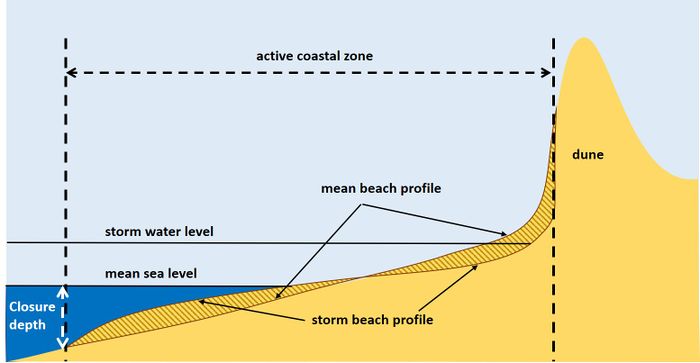Difference between revisions of "Active coastal zone"
Dronkers J (talk | contribs) |
Dronkers J (talk | contribs) |
||
| Line 16: | Line 16: | ||
==Related articles== | ==Related articles== | ||
| − | |||
* [[Definitions of coastal terms]] | * [[Definitions of coastal terms]] | ||
* [[Closure depth]] | * [[Closure depth]] | ||
* [[Shoreface profile]] | * [[Shoreface profile]] | ||
| − | |||
* [[Bruun rule]] | * [[Bruun rule]] | ||
* [[Natural causes of coastal erosion]] | * [[Natural causes of coastal erosion]] | ||
* [[Human causes of coastal erosion]] | * [[Human causes of coastal erosion]] | ||
| + | * [[Dealing with coastal erosion]] | ||
* [[Accretion and erosion for different coastal types]] | * [[Accretion and erosion for different coastal types]] | ||
| − | |||
* [[Dune erosion]] | * [[Dune erosion]] | ||
* [[Classification of sandy coastlines]] | * [[Classification of sandy coastlines]] | ||
Revision as of 12:11, 5 July 2020
Definition of Active coastal zone:
The active coastal zone (sometimes also called active coastal profile) is the beach zone over which sand is exchanged in cross-shore direction by natural processes. The seaward limit corresponds to the closure depth and the landward limit to a hard boundary (seawall, cliff, ..). In the case of a dune coast the active zone comprises part of the front dune that can be eroded by storm waves.
This is the common definition for Active coastal zone, other definitions can be discussed in the article
|
For sections of a sandy coast where no losses (or gains) of sand occur caused by gradients in littoral drift, by barrier overwash or by landward aeolian transport, the volume of sand in the active coastal zone is constant in time. However, the sand distribution within the active zone can change, see Fig. 1.
The seaward limit of the active coastal zone is the most landward depth seaward of which there is no significant change in bottom elevation and no significant net sediment transport between the nearshore and the offshore, for a given or characteristic time interval. This depth is generally called closure depth. The extent of the active coastal zone thus depends on the time scale at which changes in beach profile are considered. When considering beach evolution at seasonal time scale, the closure depth (generally called inner closure depth, [math]h_{in}[/math]) can be estimated from the yearly mean significant wave height [math]H_s[/math] by the approximate formula (for micro/meso-tidal beaches): [math]h_{in} \approx 9 H_s[/math].
When considering beach evolution at larger time scales, the seaward limit of the active zone corresponds to a larger closure depth, often designated by [math]h_{out}[/math]. Estimates for [math]h_{out}[/math] are given in the literature. It is more careful, however, to derive [math]h_{in}[/math] and [math]h_{out}[/math] from field data because the closure depth depends on local characteristics of wave climate, tide, sediment and bathymetry.
Related articles
- Definitions of coastal terms
- Closure depth
- Shoreface profile
- Bruun rule
- Natural causes of coastal erosion
- Human causes of coastal erosion
- Dealing with coastal erosion
- Accretion and erosion for different coastal types
- Dune erosion
- Classification of sandy coastlines
- Characteristics of sedimentary shores
- Coastal Hydrodynamics And Transport Processes
- Littoral drift and shoreline modelling
- Swash zone dynamics
- Beach Cusps
- Shallow-water wave theory
- Rhythmic shoreline features
- Data analysis techniques for the coastal zone
Please note that others may also have edited the contents of this article.
|
